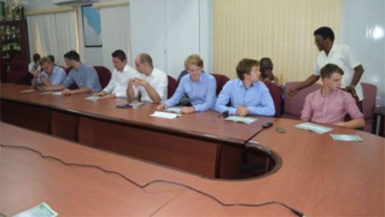A Dutch engineering team yesterday submitted a draft of a final report which is aimed at relieving the chronic flooding that has been experienced in the capital.
The report was presented in the Boardroom of the Ministry of Agriculture, by the Dutch engineering students and has to be certified by a specialist in the Netherlands, GINA said.
The project was conducted by a team of seven students working with local agencies for the modelling of an efficient drainage system for Georgetown.
The team comprising students undergoing studies leading to their Masters in Hydraulic Engineering spent approximately seven weeks working on the project.

According to the leader of the team, Joost Remmers, the project mainly looked at the catchment area of South Ruimveldt and at three main components: the local drainage system, the primary channels and the Liliendaal channel, and the outflow structures and kokers next to the Demerara River.
GINA reported that a model was created based around the storage principle. This model is used for the calculation of the theoretical delays between the water inflow into the local drainage system and the outflow to the primary channels.
The second component of the project focused on the primary channels mainly using hydraulic modelling, GINA said.
During this phase, three forms of data were collected, geometric data (what is the general route like, length of structures etc), hydraulic data which was mainly generated from analysis which was done previously on the local drainage system, and the third, about variables such as the length of time it takes to open a koker or the influence of the Liliendaal pump station on other channels.
The three types of data collected formed the basis for the hydraulic modelling which emphasised the current situation of the South Ruimveldt channel, GINA said.
The third component dealt with the examination of the structures along the Demerara River and their importance in the entire drainage system.
This included an assessment of which element has the highest probability of failure and which should therefore be prioritised for maintenance before something goes wrong.
In brief remarks, the Honorary Dutch Consul in Guyana, Ben ter Welle congratulated the student engineers.
“Students you did a nice job to help the Guyanese, it was the aim of the Kingdom of Delft. I was always told that the knowledge is here, but your contributions will help to increase the knowledge and now that you have shown where the knowledge can be, increases the major issue, is the money, so it’s now up to the Minister of Finance and the Ministry of Public Infrastructure”, he said.
Meanwhile Maxwell Jackson, Head of Department of the Faculty of Technology, Department of Civil Engineering of the University of Guyana said that the institution is proud to be associated with the project and will endeavour to ensure its continuity.
“They did the work very well…. The University of Guyana is committed to continue this process… we were able to furnish some data towards the completion of this project. The University of Guyana being the primary academic institution will continue to do verification of the model … some of our students will be examining the outfall in the Kitty area starting in the new academic year… your effort will not be in vain,” Jackson assured, according to GINA.
Deputy Mayor of Georgetown, Sherod Duncan said he is anxiously awaiting the opportunity to read the final report.
“I’m impressed by your work. The project has given me a great opportunity to learn about the interconnection of the city’s waterways. It would be a tremendous blessing to the people of South Ruimveldt. I’m really hopeful that the local government and central government follow through on your recommendations,” Duncan noted at the event.





